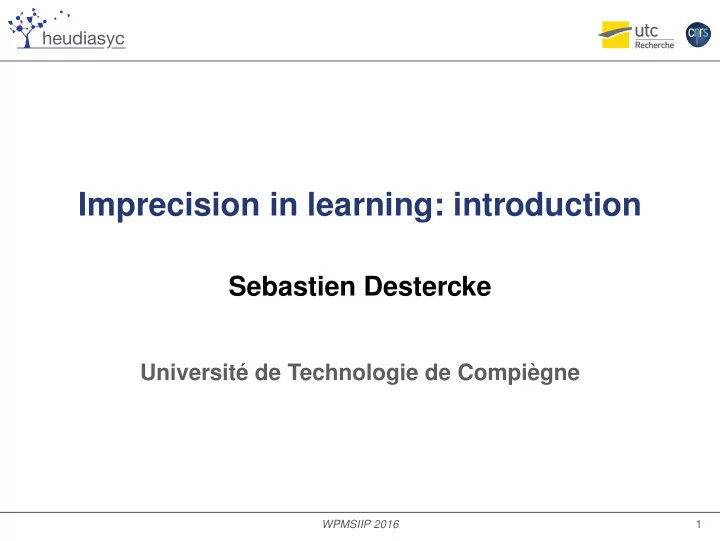

Imprecision in learning: introduction Sebastien Destercke Université de Technologie de Compiègne WPMSIIP 2016 1
Classical framework 1. A set D of (i.i.d.) precise data { x i , y i } coming from X × Y 2. Future data follow the same distribution D over X × Y 3. A precise cost/reward c ω ( y ) of predicting ω 4. Search for a model M ∗ : X → Y M ∗ = arg min � c M ( x i ) ( y i ) M ∈ M i within a set M 5. Producing precise predictions Each assumption has been questioned in the past → in which case are IP approaches relevant ? WPMSIIP 2016 2
Imprecise prediction : what exists Different approaches beyond IP : ● rejection or partial rejection using SVM, probabilistic thresholds ● conformal prediction (Vovk, Shafer, Gammerman) Despite their possible efficiency, remain a minor field of activity WPMSIIP 2016 3
Imprecise prediction : perspectives/challenges ● make efficient imprecised predictions of complex structures ❍ Graphs (block-clustering, social network analysis) ❍ Preferences/recommendations (Angela Talk) ❍ Multi-label data or multi-task problems ❍ Sequences ● how to evaluate the different models ? ● what to do with the imprecise prediction once we have it ? WPMSIIP 2016 4
Cost of imprecision Predict the rate someone would give a movie : v ery b ad, b ad, g ood, v ery g ood Truth Cost vb b g vg vb 0 1 2 3 Prediction b 1 0 1 2 g 2 1 0 1 vg 3 2 1 0 Predictions "further away" from truth worse WPMSIIP 2016 5
Imprecise costs Truth Cost vb b g vg vb 0 1 2 3 b 1 0 1 2 Prediction g 2 1 0 1 vg 3 2 1 0 {vb,b} ? ? ? ? {vb,b,g} ? ? ? ? How to fill up the matrix so that ● we can evaluate imprecise predictions ● we can learn efficiently a model that minimizes our cost WPMSIIP 2016 6
Non-identically distributed ● many problems where training { x i , y i } is assumed to follow distribution D 1 , but where new incoming data (of which you may or not have samples) may follow distribution D 2 ❍ Transfer learning (imprecise transport problem ?) ❍ Concept drift ● can imprecise probability helps here ? ● some paper looking at ill-specified prior (Minimax Regret Classifier for Imprecise Class Distributions) WPMSIIP 2016 7
Imprecise data and models ● data { X i , Y i } are now imprecise, i.e. X i ⊆ X , Y i ⊆ Y ● best model M ∗ = arg min � c M ( x i ) ( y i ) M ∈ M i no longer well-defined. WPMSIIP 2016 8
illustration m 2 X 1 5 [ R ( m 1 ) , R ( m 1 )] = [ 0 , 5 ] 3 [ R ( m 2 ) , R ( m 2 )] = [ 1 , 3 ] 4 1 2 inf R ( m 1 ) − R ( m 2 ) = − 1 m 1 inf R ( m 2 ) − R ( m 1 ) = − 2 X 2 WPMSIIP 2016 9
Imprecise data and models : some issues 1. Should we learn a set of models, or only one model ? ❍ in the first case, how to learn it efficiently and in a compact way ? (taking every replacement not possible) ❍ in the second case (most common in literature), what decision rule to pick ? Being optimistic (minimin) or pessimistic (maximin) 2. Under what assumptions about the imprecisiation process does the (optimal) model remain identifiable (Thomas talk ?) WPMSIIP 2016 10
Imprecise data and models : some issues 3. If model not identifiable (sets of possible model) ❍ which features or labels among the data { X i , Y i } should we query to improve the most our model ( active learning) ❍ in this case, can what we learn about the imprecisiation process help as well ? 4. Can the imprecisiation of the data provide more robust models ? → e.g., if we have few data WPMSIIP 2016 11
Recommend
More recommend